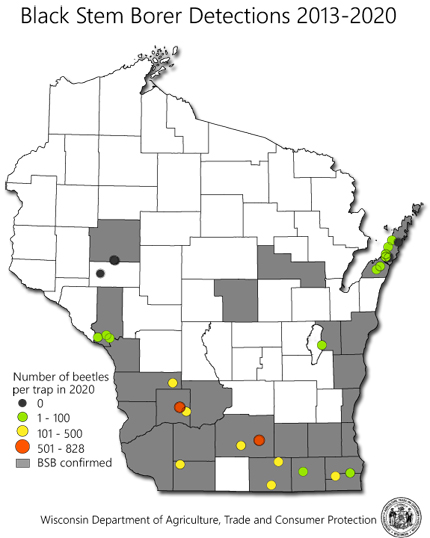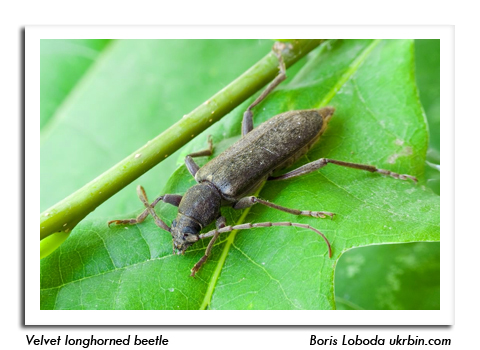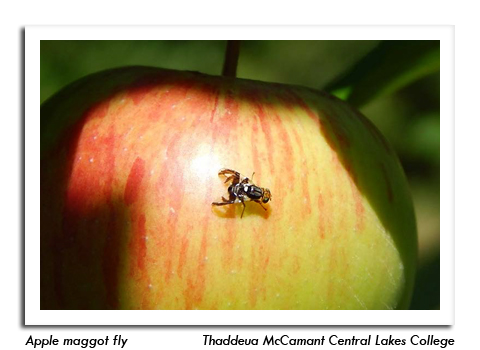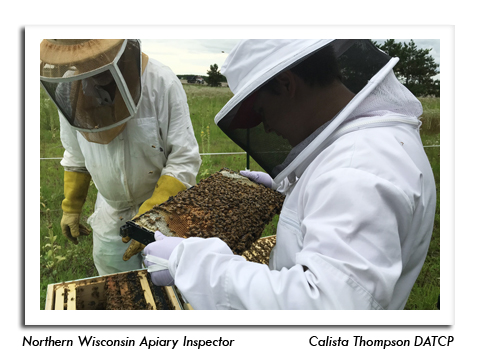
 |
|
|
Fruits
Volume 65 Number 18 Date 11/12/2020 BROWN MARMORATED STINK BUG - Monitoring was carried out at 57 sites this season. DATCP cooperators and IPM Institute consultants placed clear sticky panel traps in 45 apple orchards and 12 vineyards. Seventeen trap locations in Chippewa (2 sites), Dane (4 sites), Fond du Lac, Green, Kenosha, Racine (2 sites), Rock (2 sites), Sauk, Walworth (2 sites), and Winnebago counties captured BMSB. All traps collected fewer than 13 BMSB adults per week, with most capturing only 1-2 specimens for the season. Two new counties were added to the Wisconsin BMSB distribution map this year: Chippewa and St. Croix. Thirty-four of the state's 72 counties now have confirmed reports of BMSB. VELVET LONGHORNED BEETLE - Survey work continued in 2020 in response to the recent detection of this potential fruit and landscape tree pest in southeastern Wisconsin. The first velvet longhorned beetle (VLB) was trapped by DATCP in 2017 and surveys in the last four years have collected a total of 102 beetles in six counties: Dane, Fond du Lac, Kenosha, Milwaukee, Rock and Waukesha. The sites where VLB have been found include industrial areas near the Mitchell International Airport and apple orchards. The beetle has also been intercepted in Wisconsin in rustic hickory-style log furniture manufactured in China. In 2020, three orchard traps in Kenosha, Dane, and Rock counties each captured a single VLB, with the latter two representing new county records. The pest potential of this exotic Asian insect in Wisconsin is unclear. Although VLB is known to infest a wide range of forest, orchard and urban trees, in most states where it has been found, no local infestation or pest impact has been documented. The exception has been in Utah, where the beetle's risk to fruit trees is currently being evaluated. Ongoing trapping is planned for 2021 to understand the threat, if any, that this new pest may pose to Wisconsin orchards. CODLING MOTH - Warm dusk temperatures spurred the first emergence of spring moths in southern Wisconsin apple orchards during the last week of May. Almost half of the apple orchards in the DATCP network registered a strong flight by May 24, while other sites recorded the spring biofix on June 1. Treatments targeting first-generation larvae began around June 6, about two weeks earlier than in 2019. Summer moths appeared in early July and variable pressure was reported throughout August. A few orchards experienced late, heavy flights that led to fruit injury. Eight of the 29 sites in DATCP's monitoring program used CM mating disruption (MD) this season with success. BLACK STEM BORER - Fifty-two Lindgren funnel traps deployed in apple and cherry orchards in Calumet, Dane, Door, Kenosha, Lafayette, Racine, Richland, Rock, Trempealeau, Vernon and Walworth counties collected this Asian ambrosia beetle (Xylosandrus germanus) in 2020. Twenty-two traps captured 1-100 beetles, 18 traps caught 101-500 beetles, and two traps collected 501-828 beetles, for a total capture of 6,632 beetles. Most were collected in the two weeks from June 1-15. Until June of 2019 when an infested apple tree was identified in a Lafayette County orchard, there had been no confirmed cases of BSB apple tree damage in Wisconsin. Orchards in Michigan, Ohio and other northeastern states have had serious issues with this pest in the last few years, and in western New York, the beetles have killed large numbers of apple trees. Results of the 2020 survey provide further evidence of BSB's prevalence in the state and suggest future orchard monitoring is needed. Black stem borer has been documented by DATCP in 25 Wisconsin counties since 2013. APPLE MAGGOT - Emergence of flies began in orchards by June 28. Counts generally peaked between July 22-28 in the south and August 12-18 in the north. A few monitoring sites also reported high counts (5-12 per trap) during the last week of August, despite the long dry spell. The season's highest weekly count was 24 flies on red sphere traps in Fond du Lac and Kenosha counties. EUROPEAN CHERRY FRUIT FLY - A pest detection survey was conducted on the Door Peninsula of northeastern Wisconsin from 2018-2020 for the European cherry fruit fly (ECFF), Rhagoletis cerasi. First found in North America in Ontario in 2015 and two years later in New York, ECFF is a pest of economic and quarantine significance that poses a high risk to Door County's $1.9 million dollar tart cherry crop. Surveys for ECFF were conducted at eight orchards, and included the placement of four yellow sticky traps (32 traps total) baited with ammonium carbonate attractant at each location. No ECFF were captured on any of the traps during the three-year survey. -- Krista Hamilton, DATCP Entomologist APPLE DISEASES - Consultants from the IPM institute scouted 18 orchards as part of a multi-year collaborative survey that targeted nine apple diseases of special concern to agriculture in the state. Notable diseases found by the survey were crown gall (2 positives) and fire blight (2 positives). The positive samples were collected from sites in Chippewa, Portage, Rock and Trempealeau counties. Other apple disorders diagnosed this season were flyspeck, Phomopsis canker, and rust. FIREBLIGHT - This bacterial blight caused by Erwinia amylovora was common in 2020. The lab confirmed the disease on nine apple tree and three pear tree samples. The infected apple varieties were 'Candy Crisp,' 'Cortland,' 'Honeycrisp,' 'Firestorm Honeycrisp,' 'Jonathan,' and 'State Fair.' 'Anjou semi-dwarf CVI,' 'Parker' and 'Patten' pears tested positive for the bacterial blight. -- Anette Phibbs & Sam Fieweger, DATCP Plant Industry Lab APIARY INSPECTIONS - Apiary inspections are still underway. Inspectors have to date visited 120 beekeepers, opening 1,128 hives for inspection. Preliminary results indicate that winter mortality decreased for the third year in a row, from 32% in 2018-19 to 21% in 2019-20, which is close to the 22% national average for winter loss. Varroa mite was detected in 59% of hives sampled for this pest, compared with 51% last season. Other pests and diseases found include American foulbrood in 0.4% of hives, chalkbrood in 6.9% of hives, European foulbrood in 0.9%, deformed wing virus in 7.4%, sacbrood in 8.7%, and small hive beetle in 0.1% of hives. These numbers will likely change once inspections are completed. As of November 12, inspectors have issued apiary inspection certificates for the movement of 16,267 migratory hives, primarily destined for California, Florida and Texas for pollination services. -- Liz Meils, DATCP Nursery Inspector 





|
|
|